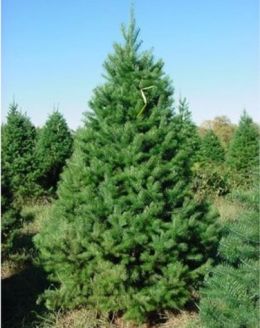Choosing The Perfect Christmas Tree

When choosing a live Christmas tree, you want to make sure that you have all of your measurements just right. You want to make sure that before you leave the house you know exactly where you're going to put the tree, and around about what size you're going to look for.
The tree placement is important because you want to make sure that you don't place the tree near a heat source, such as a sunny window, fire place, or radiator. You should also find a place that will be out of a high traffic area where the tree may get knocked over or where someone may trip on the light cords. Consider putting the tree in the corner of a room.
When measuring, you'll want to make sure to measure twice. You want to take your tape measure and measure:
- Ceiling height and the width of the space (width is important when putting the tree in a corner- measure from wall to wall).
- The tree stand so that you know the maximum diameter of the tree trunk that will fit in the stand.
- The height of the tree stand and the height of your treetop decoration (if you plan on using one) so that you know how much room you have to spare.
Remember to take you paper with your measurements and your tape measure with you when you go to pick out a Christmas tree.
You may also want to breed heavy gloves to protect your hands, and an old blanket to protect your car from sap and pine needles.
Tips for Choosing a Christmas Tree
When selecting a tree, you want to consider the different types of trees that are used and sold as Christmas trees.
When
choosing what tree you want to use, many people prefer those with
shorter needles, such as Fraser or Noble Fir trees, because these are
generally easier to decorate because they have more space between the
branches. In many cases, these trees will also have stronger limbs and
stems to hold heavier ornaments.
You'll also want to
consider the space between the branches. You'll find that the more
space between the limbs will allow for ornaments to hang, and when they
hang straight down, they'll look better. Most trees, though, are lush
and full so the ornaments will hang at an angle. You can bring an
ornament when you go tree hunting so that you can test the branches.
You'll want to make sure that you choose a tree that is fresh. You'll want shiny, green needles. The green needles shouldn't fall off when you pull on a branch or gently shake the tree. Avoid trees that are a blue-gray color and those with a lot of brown needles.
And of course, check the trees for insects and insect eggs. In most cases, the lot will have a shaker to shake off dead needles. The bugs will fall off too, but it's still something you want to check the tree for before you bring it into your house.



Types of Christmas Trees
Because there are different types of trees that you can use as a
Christmas tree, it's good to be prepared for the main features of the
more common types of Christmas trees before you pick a tree out that
ends up smelling up your house.
Common trees that are used as Christmas trees include:
- Balsam Fir: Needles are 0.75-1.5" in length and last a long time. Dark green color and retains fragrance throughout season.
- Colorado Blue Spruce: Sharp needles that are 1-1.5" in length with good retention. Blue-gray color and has a bad fragrance when the needles are crushed. Good symmetrical shape.
- Concolor Fir: Small narrow needles are 1-1.5" in length are in rows and typically have good retention. Good green color, pleasing shape, and a nice fragrance.
- Douglas Fir: Needles are 1-1.5" in length. They are dark green to a blue green color that grow in a circular pattern. When the needles are crushed they have a sweet fragrance. One of the favorite Christmas trees in the US.
- Fraser Fir: Branches are turned slightly upward. The needles have good retention. Dark blue green color. The tree has a nice fragrance.
- Leyland Cypress: Dark green to gray color with very little aroma. No sap. Most popular Christmas tree in the Southeast.
- Noble Fir:
Upward turned needles that expose the lower branches. Stiff branches,
which are good for heavy ornaments. Known for beauty and longevity.
- Scotch Pine: Needles are about 1" in length. They don't fall, not even when dry. Bright green in color. Retains longevity throughout the season. Most popular Christmas tree in the US.
- Virginia Pine: Stout and woody branches that are easily trimmed. Dense foliage. Small/ medium sized tree. Most popular Christmas tree in the South.
- White Pine: Soft, flexible needs that are about 2.5-5" in length and hold a blue green color. Typically have good needle retention and little fragrance. Not recommended for heavy ornaments
- White Spruce: Needles are 0.5-0.75" in length with a long, blunt tip and blue green-green color. Great tree for ornaments. Bad fragrance when the needles are crushed, but they have an excellent color, natural shape, and decent needle retention.
Live Tree VS Artificial
Live Christmas Tree
- Fragrance
- Uniqueness
- Family time choosing the right tree
- Repeated annual cost
- Constant clean-up of dropped needles
- Dry tree which can be a fire hazard
- Risk of spiders and other insects
- Christmas tree disposal
Artificial Christmas Tree
- No needle clean-up from dropped dead needles
- No tree disposal
- The tree won't dry out
- Cheaper because it's a one time cost
- Wide range of sizes, shapes, colors, and types
- Some are pre-lit, reducing the hassle of stringing lights
- No scent
- Time consuming to put together and then break down
- Need space to store the tree when not in use

Christmas Tree Tips
- Choosing a Christmas Tree Topper
A Christmas tree topper is pretty simple; it's a Christmas decoration that goes on top of the tree. - Tips for Decorating a Christmas Tree
When decorating a Christmas tree, you'll find that it really becomes a challenge to create a tree that is going to be pleasing to the eye versus a complete eye sore. - Pre-lit Artificial Christmas Tree
It used to be a near sin to purchase an artificial Christmas tree for the winter holidays, but now it has become more and more common for families to purchase a fake Christmas tree versus buy a real... - Christmas Tree Skirt
It used to be a near sin to purchase an artificial Christmas tree for the winter holidays, but now it is more common to purchase an artificial tree.










